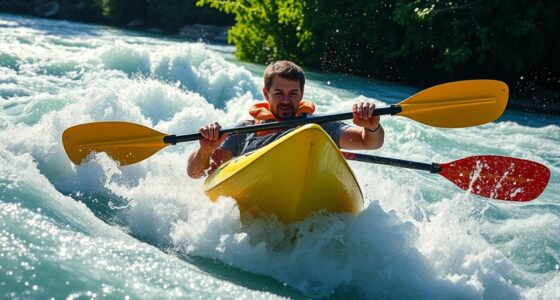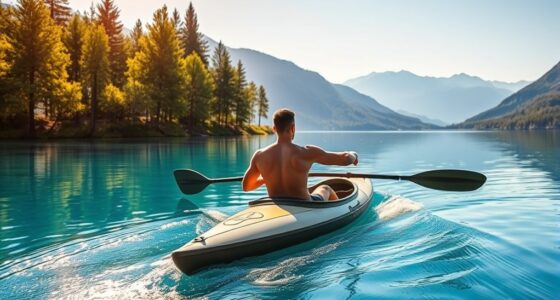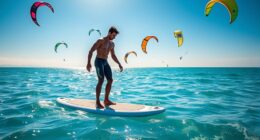When kayaking, wearing a properly fitted life jacket is essential for your safety and peace of mind. It should be snug enough to stay in place but still allow for comfortable movement. Don’t forget a paddle leash; it prevents your paddle from drifting away if you drop it, keeping everything secure. Remember to check the condition of your gear before each trip and stay aware of your surroundings. There’s more to explore about staying safe on the water.
Key Takeaways
- Always wear a properly fitted life jacket while kayaking for safety and legal compliance.
- Ensure the life jacket allows for comfortable movement and doesn’t ride up during paddling.
- Use a paddle leash to prevent losing your paddle if it slips from your grip.
- Regularly check the condition of your life jacket and paddle leash before heading out.
- Inform someone about your kayaking plans and check weather conditions for a safer experience.

Whether you’re a seasoned paddler or a beginner, understanding kayaking safety essentials is vital for an enjoyable experience on the water. One of the most important aspects of kayaking safety is wearing a life jacket. It’s not just a recommendation; it’s often a legal requirement. A good-fitting life jacket can keep you afloat in emergencies, giving you peace of mind while you focus on your paddle stroke techniques. Make sure your life jacket fits snugly but allows for movement. You should feel comfortable while paddling, as a poorly fitting jacket can restrict your motion and become a safety hazard.
Understanding kayaking safety, especially wearing a well-fitting life jacket, is essential for a secure and enjoyable experience on the water.
Additionally, having a leash for your paddle can prevent it from drifting away if you accidentally drop it. This simple piece of gear can save you from a frustrating situation where you need to swim to retrieve your paddle. With your gear secured, you can concentrate on improving your paddle stroke techniques. Whether you’re practicing forward strokes, sweeps, or reverse strokes, knowing how to maneuver your kayak effectively can enhance your safety and performance.
Proper kayak storage is another crucial safety aspect. After a day on the water, ensure you store your kayak in a dry, secure place to prevent damage. If you leave it exposed to the elements, you risk degrading the materials and compromising its integrity. When storing, consider using a padded rack or a dedicated storage space to avoid unnecessary wear and tear. If you’re using a garage or shed, keep it off the ground to prevent moisture build-up, which can lead to mold or mildew.
Before heading out, always check your gear. Make sure your life jacket is in good condition and your paddle leash is intact. It’s also wise to inform someone about your paddling plans and expected return time. This way, someone will know to check on you if you don’t return as expected.
Finally, remember to stay aware of your surroundings while on the water. Watch for changing weather conditions, other boats, and obstacles. By following these kayaking safety essentials, you not only protect yourself but also enhance your overall paddling experience. Whether you’re gliding across a calm lake or navigating a swift river, safety should always be your top priority. Enjoy your time on the water, and keep these essentials in mind for a fun and secure adventure! Additionally, ensuring your gear is in good condition can help prevent unnecessary risks during your kayaking trips.
Frequently Asked Questions
What Types of Life Jackets Are Best for Kayaking?
For kayaking, you’ll want to choose a life jacket that fits snugly and allows for movement. Type options like Type III vests are great for recreational paddling, while Type II jackets offer more flotation. Look for material choices like nylon or neoprene for durability and comfort. make sure it has adjustable straps and enough buoyancy for your weight. Don’t forget to check for extra features like pockets and reflective strips for safety!
How Should a Life Jacket Fit for Optimal Safety?
A life jacket should fit snugly without restricting your movement. To guarantee a proper fit, adjust the straps so it stays in place when you lift your arms. You shouldn’t be able to pull it over your head easily. Flotation adjustment is key; the jacket must provide enough buoyancy to keep you afloat. Always test it in the water to confirm it keeps you safe and secure while you paddle.
Are There Age Restrictions for Wearing Life Jackets?
Life jackets are like a safety net, bridging the gap between adventure and precaution. There aren’t specific age restrictions for wearing life jackets; however, regulations vary by state. Generally, children under 13 must wear one while on the water. Always check local life jacket requirements to make sure everyone’s protected. Regardless of age, making sure everyone’s properly fitted and comfortable in their life jackets can turn a risky trip into a secure one.
Can I Kayak Without a Leash in Calm Waters?
You can kayak without a leash in calm waters, but it’s not always the best choice. While the water conditions might seem friendly, having a leash can prevent losing your kayak gear if you capsize. It’s better to stay prepared, even in serene environments. By securing your gear, you’ll ensure a more enjoyable experience and reduce the risk of accidents. So, consider using a leash, even when things look calm.
What Should I Do if My Leash Gets Tangled?
If your leash gets tangled, stay calm and assess the situation. Did you know that over 70% of kayaking accidents can be avoided with proper tangle prevention? First, try to gently untangle the leash while maintaining your balance. If that doesn’t work, use rescue techniques like flipping your kayak or swimming to a safe spot. Always remember to check your gear before setting out to minimize future tangles.
Conclusion
In summary, staying safe while kayaking is all about being prepared. Always wear your life jacket and use a leash for your paddle—these simple steps can make a world of difference. Remember, it’s not just about having fun on the water; it’s about coming back safely to tell the tale. So, why not take a moment to double-check your gear before you head out? Your safety should always be your top priority!










